To read the full report, please download PDF.
BoJ turns hawkish – but limited impact for now
FX View:
The yen has gone from the top performing G10 currency last week to the worst performing this week as the impact of probable yen buying intervention fades. What has been notable this week is the shift by the BoJ to a more hawkish tone that points to building confidence on the “virtuous cycle in wages and inflation”. We assess this shift in the context of what’s to come and maintain a view of a July rate hike. While a June hike still seems unlikely, it can’t be ruled out completely. We also analyse the potential signs of cracks in the US dollar bull-run and maintain our view that the dollar will turn weaker on a more sustained basis later in the year. US inflation data next week will be the key event and we should see wider trading ranges for the dollar versus G10 than what we witnessed this week bar the move in the yen.
JPY RETRACES SOME OF LAST WEEK’S SURGE

Source: Bloomberg, 14:20 BST, 10th May 2024 (Weekly % Change vs. USD)
Trade Ideas:
Given the gradual turn weaker of the US dollar we have instigated a long EUR/USD trade idea, cut our long AUD/NOK trade and maintained our long EUR/GBP trade.
JPY Flows – Portfolio, sector by sector :
The MoF today released the monthly International Transactions in Securities which revealed selling of foreign bonds by Japanese banks and a renewed pick-up in purchase of Japanese equities by foreign investors. Investment Trust buying of foreign equities also continued.
FX Correlations Heatmap :
AUD/USD and NZD/USD have had the strongest correlations with US rates over the past month. The recent paring back of Fed rate cut expectations has encouraged a broad USD rally against other G10 currencies. On the whole G10 FX correlations have been stronger on average with short-term rather than long-term US rates.
FX Views
JPY: BoJ turns more hawkish but impact will be limited for now
USD/JPY hit a low last Friday of 151.86 following two probably bouts of intervention but since that low on Friday, USD/JPY has this week steadily moved higher and has now retraced the majority of the correction lower following the second bout of intervention last Wednesday. The move of the yen is likely becoming an increasingly concerning issue in Tokyo and we believe is shifting the attitudes of the BoJ in regard to the risks associated with yen depreciation. It was very notable this week to observe the stark shift in rhetoric from BoJ Governor Ueda following one of his regular meetings with PM Kishida. There is no formal set structure in terms of timing or regularity of these meetings so it is not unreasonable to believe that this could easily have been initiated by the prime minister and hence could reflect the increased concerns over FX developments. So what will this mean for BoJ policy going forward and from that for the direction of the yen?
Immediately following the meeting with PM Kishida on Tuesday, Governor Ueda provided a normal and bland comment on the yen stating that the BoJ would “closely monitor” how yen weakness would impact inflation. On Wednesday though Ueda’s tone had changed firstly in the Diet where he stated that a policy response may be required and that FX was “an important factor” impacting inflation. Then later on Wednesday speaking at a conference in Tokyo Ueda went further still stating that “abrupt, one-sided moves weaker for the yen is negative for the economy”, adding that it was “vital” that FX levels reflect fundamentals. The shift seems clear and while it could therefore easily be interpreted as possible political interference in monetary policy deliberations, minutes from the BoJ policy meeting in April do also point to the fact that the shift to a more hawkish stance may have preceded this week’s meeting with PM Kishida. The minutes of the meeting, released yesterday, revealed greater attention given to FX and the inflation impact and the need for “deeper discussions” on the timing of a rate hike. There was also a call from one member to look at cutting bond purchases based on projected supply going forward.
While market participants will understandably put this down to political pressure given the meeting this week between PM Kishida and Ueda, the BoJ likely sees building evidence elsewhere to increase confidence that additional rate hikes are warranted.
Cash earnings data were released this week – we know the importance of wage data for BoJ decision-making – and the same-sample cash earnings increased on an annual basis from 1.9% in February to 2.2% in March, in line with consensus. Schedule full-time pay YoY increased from 2.1% to 2.3%, much stronger than the 1.9% consensus. Given the Rengo wage negotiated rate currently stands at 5.2%, some 1.5ppts higher than a year ago, it remains very likely that actual wage data will continue to accelerate from here.
JPY STARTING TO UNDERPERFORM THE BROADER MARKET AGAIN

Source: Bloomberg, Macrobond & MUFG GMR
USD/JPY & US-JAPAN 10-YEAR SPREAD SINCE INTERVENTION IN 2022
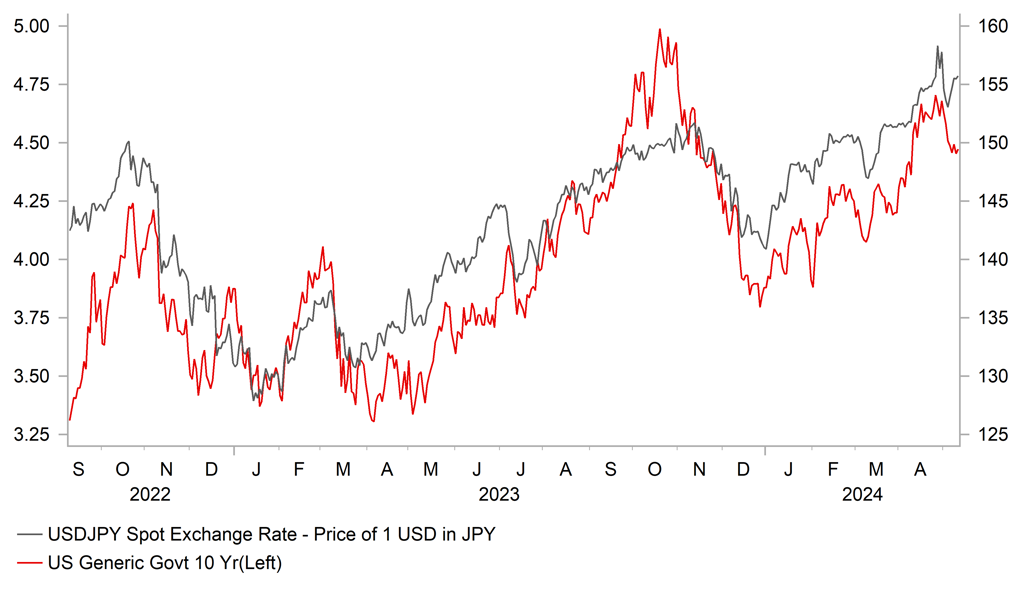
Source: MUFG & Global Markets Research
The speech referred to above on Wednesday has been published in English on the BoJ website (here) and certainly suggests the passing of time that allows the BoJ to gather more information is resulting in increased confidence over the “virtuous cycle between wages and prices” (the title of the speech!) and in this speech Ueda stated that small and medium-sized firms were facing “a pronounced labour shortage” and even in companies facing difficult business conditions were having to increase wages. This strongly points to the broader Rengo wage estimate remaining elevated and feeding higher wage growth. As stated here before, it is important to remember that in a five-year period since 2018, Japan’s working age population has declined by 1 million for the first time ever. Labour conditions now are unique. Ueda also refers to the Tankan and longer-term inflation expectations hitting a new high. Utility subsidies are set to end this month and tax cuts are set for households in June, so inflation looks set to accelerate from June onwards which argues for more BoJ rate hikes.
The yen has gone from the best performing G10 currency last week to the worst this week as yen selling resumes. As mentioned here before, the BoJ policy rate is real terms of over -200bps is a real impediment for a sustained turn stronger. The tone of comment this week from the BoJ suggests this is now prompting a more hawkish stance from the BoJ. The OIS curve out to 3yrs indicates a policy rate of 0.70% and the 3mth TONA futures at the end of 2028 is at 0.90% which indicates to us that market pricing of the terminal rate in Japan is too low. The BoJ through communication and action will likely drive that higher this year as the wage-price virtuous cycle strengthens further. We still expect a July rate hike of 15bps although we can’t rule out an earlier move in June. Given this could look like political influence, July seems more probable but the shift in tone this week is notable.
While the determinant of changes in the US-Japan spread will primarily rest with the Fed, we should not dismiss the potential importance of a more hawkish BoJ that helps lift the terminal rate pricing and reduce the size of the negative policy rate in real terms. USD/JPY back below 150.00 by year-end remains a plausible scenario.
RENGO ‘SHUNTO’ WAGE AGREEMENT LEVEL – OVERALL & BASE SALARY
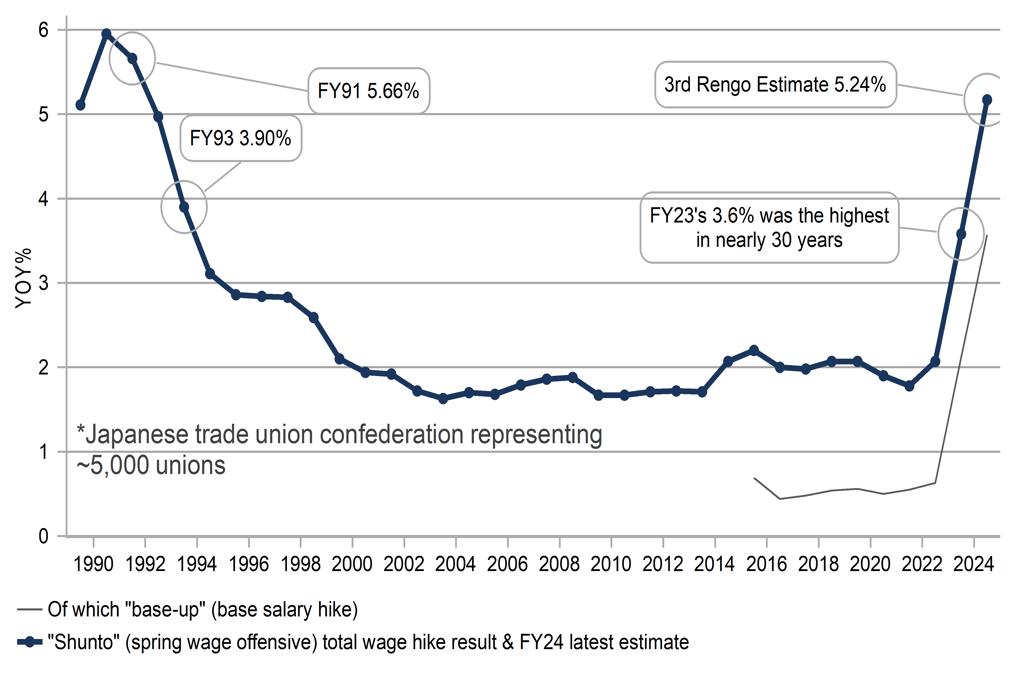
Source: Bloomberg, Macrobond & MUFG GMR
1YR; 2YR & 3YR FORWARD BOJ POLICY RATES AT POST-GFC HIGHS BUT FURTHER TO GO
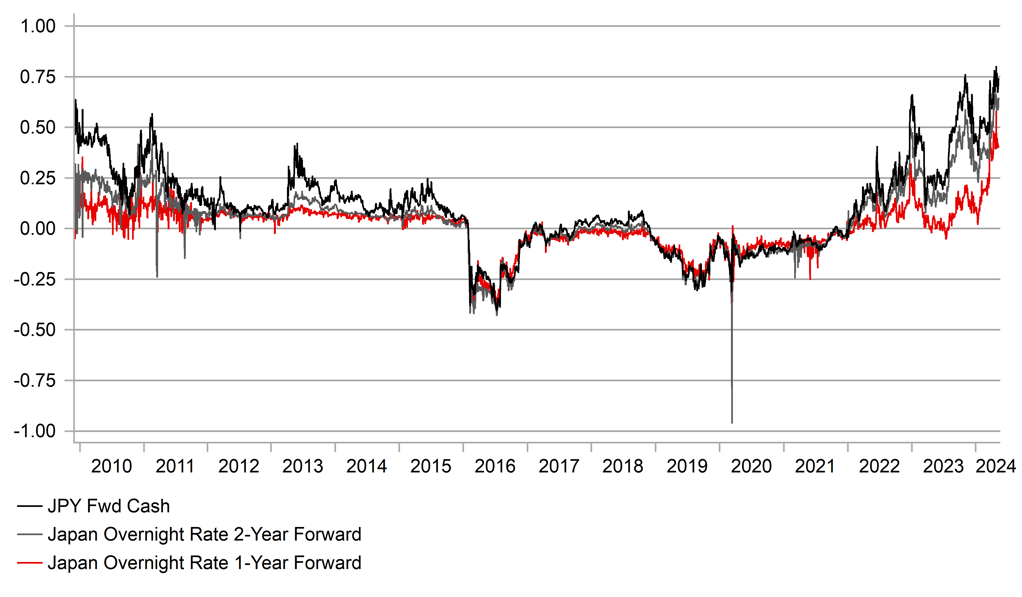
Source: Bloomberg, Macrobond & MUFG GMR
USD: What’s behind the USDs recent loss of upward momentum?
The USD has lost upward momentum over the past month. After hitting a high on 16th April at 106.52, the dollar index since corrected modestly lower by just over 1.0% as it has fallen back towards the 105.00-level. The main beneficiaries of the recent loss of upward momentum for the USD have been the high beta G10 commodity currencies of the AUD (+3.3%), NZD (+2.3%) and NOK (+1.5%), and the EUR (+1.5%) while the JPY has remained at weaker levels against the USD. The recent loss of upward momentum for the USD has resulted in G10 FX volatility falling back towards year to date lows after it threatened to break higher in April. A favourable development for FX carry trades.
One of the reasons why the USD has lost upward momentum has been building evidence that economic growth has picked up outside of the US at the start of this year. The strength of the economic recovery has been more pronounced than expected in Europe. The euro-zone economy expanded by 0.3%Q/Q in Q1 which was the fastest quarter of growth since Q2 2022. Furthermore, it has been confirmed that the UK economy exited technical recession in Q1 when it expanded well above expectations by 0.6%Q/Q in Q1. The BoE was initially expecting growth of just +0.1%Q/Q although headline growth was flattered by a large +0.44ppt contribution from net trade as imports fell sharply. Leading indicators are suggesting that improving growth momentum will continue heading into the middle of this year. In the UK some payback weakness is likely in Q2. China’s economy has picked up as well at the start of this year expanding by 1.6%Q/Q in Q1. The release of the latest monthly activity data (retail sales, FAI & IP) for April in the week ahead will be watched closely to see if upward momentum can be sustained.
At the same time, the US economy has continued to grow strongly at the start of this year although there been more signs recently that growth could slow more going forward. The US economy slowed modestly to an annualized rate of 1.6%% in Q1 following robust but unsustainable growth of 4.1% in the 2H of last year. The breakdown did reveal though that private domestic demand stripping out inventories continued to expand strongly by around 3% for the third consecutive quarter. More recently, the run of US economic data at the beginning of Q2 has started to disappoint. The widely followed Citi US Economic Surprise Index on Bloomberg has fallen into negative territory and to the lowest level since January of last year. It highlights that the recent run of upward revisions to US GDP forecasts is coming to an end. The Bloomberg consensus US GDP forecast for this year has already been already been raised by 1.1ppt to 2.4% since the end of last year.
ARE US YIELDS & USD PEAKING OUT AGAIN?
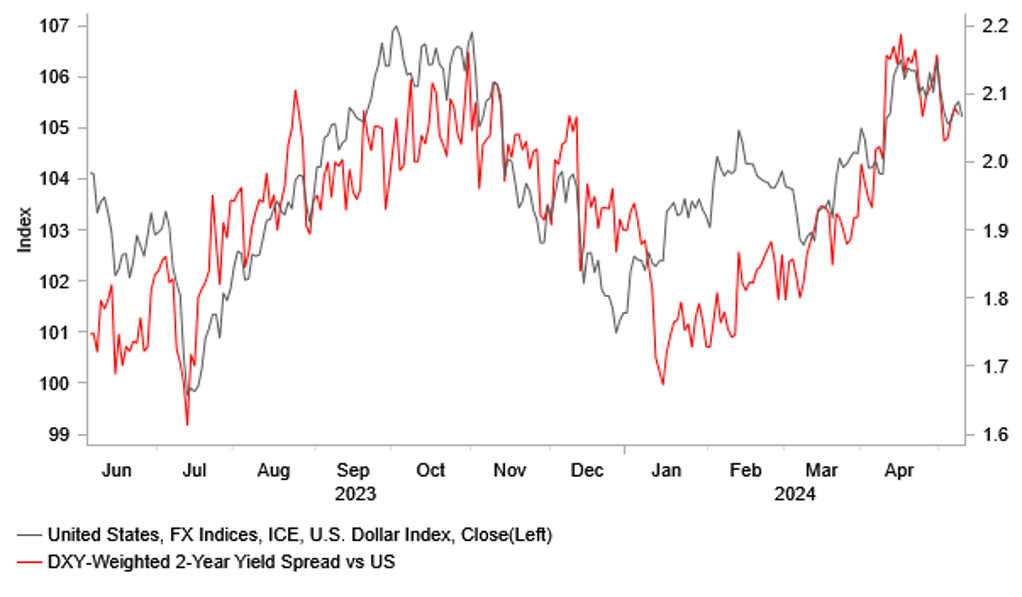
Source: Bloomberg, Macrobond & MUFG GMR
GEOPOLITICAL RISKS IN MIDDLE EAST HAVE EASED
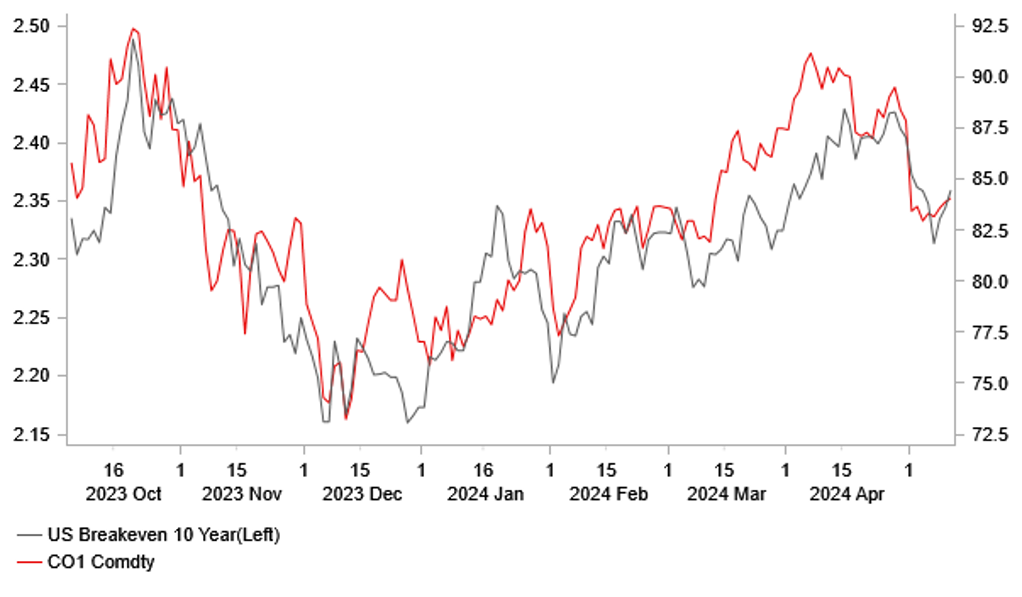
Source: Bloomberg, Macrobond & MUFG GMR
The risk of a bigger correction lower for the USD would increase in the coming months if hard evidence begins to emerge as well backing up the soft survey data that is pointing towards much weaker US growth. The USD sell-off following the release of the latest nonfarm payrolls report for April and this week’s initial claims highlights that there is more concern that stronger employment growth at the start of this year will not be sustained. A sharp slowdown in employment growth in the coming months would support our forecast for the Fed to deliver multiple rate cuts in the second half of this year. We continue to believe that the US rate market has gone too far in scaling back expectations for Fed rate cuts this year.
The main challenge in the week ahead to our view that US rates and the USD are in the process of peaking out will be the release of the latest US inflation reports (CPI & PPI) for April. A fourth consecutive monthly upside inflation surprise is required to inject fresh upward momentum into US rates and the USD in the near-term. Whereas in line or softer prints could see the USD give back more of the gains from the start of this year. A fourth consecutive upside inflation surprise would increase the likelihood of the Fed dropping more rate cuts from their updated plans at the next FOMC meeting on 12th June. It is still difficult though to see the Fed completely dropping plans for rate cuts this year after planning 3 cuts not so long ago in March. The Fed’s reluctance to deliver an even more hawkish policy update at their last policy meeting on 1st May is another reason why the USD has lost upward momentum recently.
The USD’s upward momentum has been dampened as well by the pushback from officials in Asia including Japan and South Korea who have raised concerns over domestic currency weakness. Japan intervened on two occasions last week to support the yen with USD selling estimated to have totalled around USD59 billion. We expect Japan to intervene again if the JPY quickly falls back to recent lows at just above the 160.00-level for USD/JPY. At the same time, we have highlighted that JPY weakness could encourage the BoJ to bring forward plans for further monetary tightening. The developments should discourage a further build-up of long speculative USD positions that are already stretched.
In summary, we are wary of chase the USD higher right now even as monetary policy is beginning to diverge between the Fed and European central banks who are moving to cut rates earlier. We are waiting for confirmation that US yields and the USD are peaking out.
CYCLICAL MOMENTUM IS MOVING AGAINST THE USD
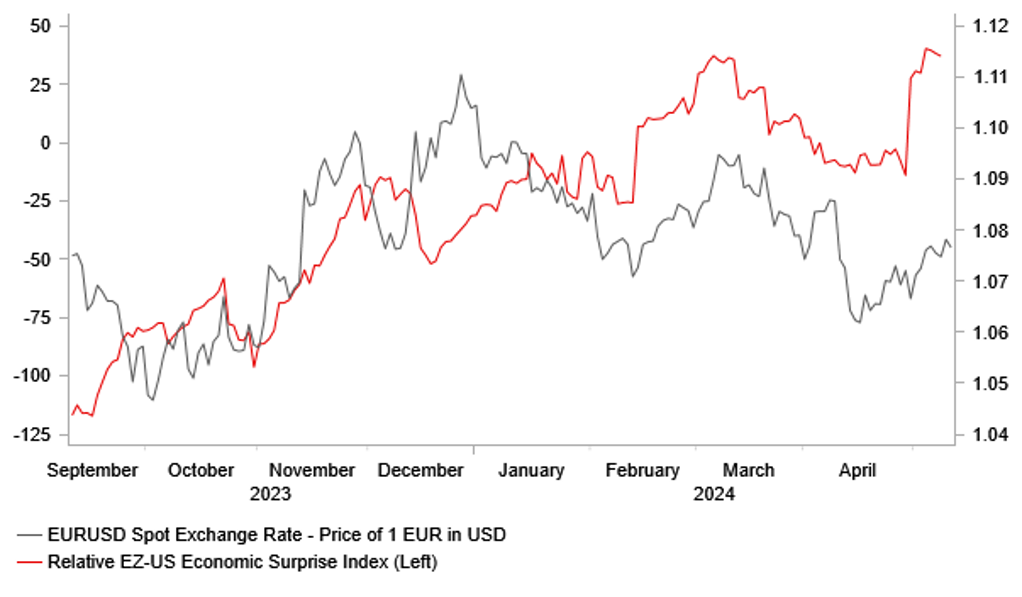
Source: Bloomberg, Macrobond & MUFG GMR
LONG USD POSITIONING HAS BECOME STRETCHED
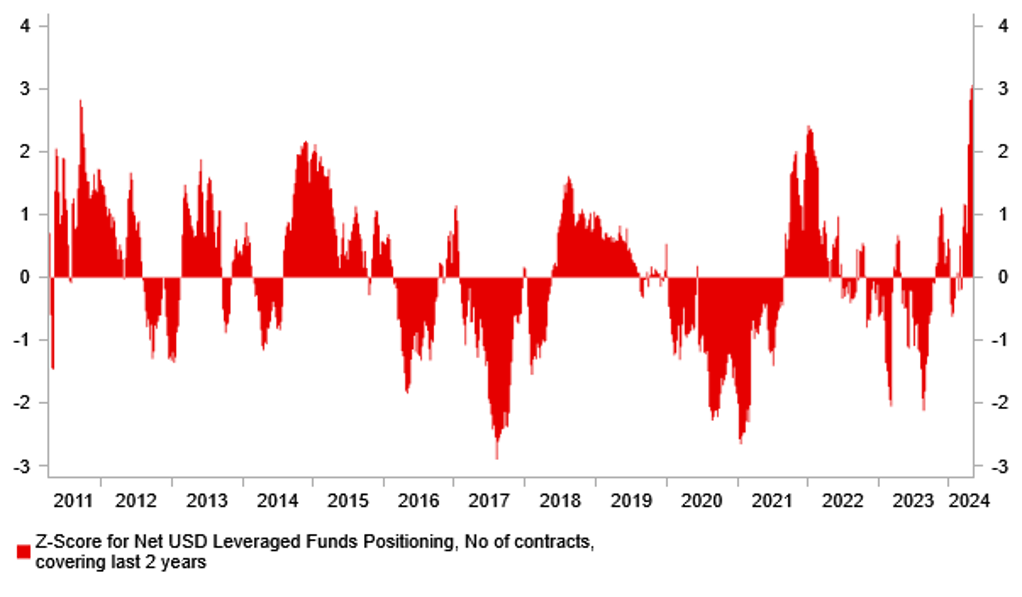
Source: Bloomberg, Macrobond & MUFG GMR
|
Ccy |
Date |
BST |
Indicator/Event |
Period |
Consensus |
Previous |
Mkt Moving |
|
CHF |
05/13/2024 |
17:45 |
SNB's Jordan and IMF's Georgieva Speak |
!! |
|||
|
GBP |
05/14/2024 |
07:00 |
Output Per Hour YoY |
1Q P |
-- |
-0.3% |
!! |
|
EUR |
05/14/2024 |
07:00 |
Germany CPI YoY |
Apr F |
-- |
2.2% |
!! |
|
GBP |
05/14/2024 |
07:00 |
Average Weekly Earnings 3M/YoY |
Mar |
-- |
5.6% |
!!! |
|
GBP |
05/14/2024 |
07:00 |
Employment Change 3M/3M |
Mar |
-- |
-156k |
!!! |
|
GBP |
05/14/2024 |
08:30 |
BoE Chief Economist Pill Speaks |
!!! |
|||
|
EUR |
05/14/2024 |
10:00 |
Germany ZEW Survey Expectations |
May |
-- |
42.9 |
!! |
|
USD |
05/14/2024 |
11:00 |
NFIB Small Business Optimism |
Apr |
88.2 |
88.5 |
!! |
|
USD |
05/14/2024 |
13:30 |
PPI Final Demand YoY |
Apr |
2.1% |
2.1% |
!!! |
|
EUR |
05/14/2024 |
15:00 |
Fed Chair Powell, ECB's Knot Speak |
!!! |
|||
|
AUD |
05/15/2024 |
02:30 |
Wage Price Index YoY |
1Q |
4.3% |
4.2% |
!!! |
|
SEK |
05/15/2024 |
07:00 |
Sweden CPI YoY |
Apr |
-- |
4.1% |
!! |
|
EUR |
05/15/2024 |
07:45 |
France CPI YoY |
Apr F |
-- |
2.2% |
!! |
|
EUR |
05/15/2024 |
09:00 |
ECB's Rehn Speaks |
!! |
|||
|
EUR |
05/15/2024 |
10:00 |
GDP SA QoQ |
1Q P |
-- |
0.3% |
!! |
|
EUR |
05/15/2024 |
10:00 |
Employment QoQ |
1Q P |
-- |
0.3% |
!! |
|
EUR |
05/15/2024 |
10:00 |
ECB's Villeroy speaks |
!! |
|||
|
USD |
05/15/2024 |
13:30 |
CPI YoY |
Apr |
3.4% |
3.5% |
!!! |
|
USD |
05/15/2024 |
13:30 |
Retail Sales Advance MoM |
Apr |
0.4% |
0.7% |
!!! |
|
JPY |
05/16/2024 |
00:50 |
GDP Annualized SA QoQ |
1Q P |
-1.5% |
0.4% |
!!! |
|
AUD |
05/16/2024 |
02:30 |
Employment Change |
Apr |
25.0k |
-6.6k |
!!! |
|
NOK |
05/16/2024 |
07:00 |
GDP QoQ |
1Q |
-- |
1.5% |
!! |
|
USD |
05/16/2024 |
13:30 |
Initial Jobless Claims |
-- |
-- |
!! |
|
|
USD |
05/16/2024 |
13:30 |
Housing Starts |
Apr |
1440k |
1321k |
!! |
|
USD |
05/16/2024 |
14:15 |
Industrial Production MoM |
Apr |
0.2% |
0.4% |
!! |
|
CNY |
05/17/2024 |
03:00 |
Industrial Production YoY |
Apr |
5.4% |
4.5% |
!! |
|
CNY |
05/17/2024 |
03:00 |
Retail Sales YoY |
Apr |
3.8% |
3.1% |
!! |
|
EUR |
05/17/2024 |
10:00 |
CPI YoY |
Apr F |
2.4% |
2.4% |
!! |
Source: Bloomberg, Macrobond & MUFG GMR
Key Events:
- The main economic data releases in the week ahead will be the latest US CPI and PPI reports for April. The pick-up in core inflation pressures at the start of this year has already prompted a significant paring back of Fed rate cut expectations. The US rate market is no longer fully pricing in multiple rate cuts by the Fed this year with the timing of the first cut pushed back until November. Looking back at the reaction of the USD to recent US CPI report releases, the dollar index has strengthened in the first hour following the last five reports by an average of +0.5%. Another month of stronger US inflation may even prompt US rate market participants to start to more seriously question if the Fed will begin to cut rates at all this year. In contrast, softer US inflation prints for April would bring some much needed relief and support the Fed’s view that higher inflation at the start of this year is just a bump in the road to slower inflation.
- Last month’s release of the US retail sales report for March proved to be surprisingly robust with control sales increasing by the largest amount since January 2023. It has since been revealed that personal consumption slowed in Q1 although remained strong when it expanded by 2.5%. The retail sales report for April will be watched closely to see if personal consumption is likely to slow further in Q2.
- The other main economic data releases in the week ahead will be: i) UK labour market report for March, ii) the Australian labour market report for April and wage price report for Q1, and iii) the latest monthly activity data from China for April including retail sales, industrial production and fixed asset investment. The BoE will be looking for further evidence that the UK labour market is softening and wage growth continues to moderate to open up more room to begin cutting rates. The RBA has indicated that it remains comfortable for now to keep rates higher for longer in response to the recent upside inflation surprises. After picking up in Q1, market participants will be watching closely to see if China’s economy can sustain stronger growth in Q2.

